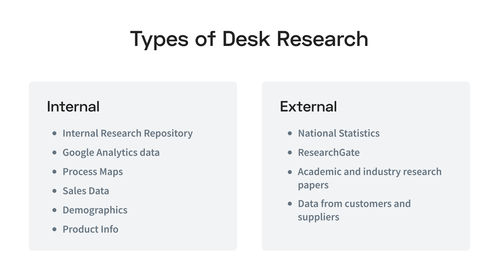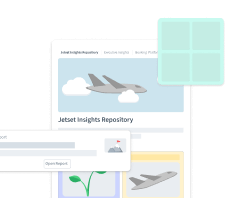
The Power of Desk Research in User Research
As a skilled researcher, you already know that desk research is a key component of user research. You also know that it is so much more than merely collecting data. It helps you frame the scope of your projects, informs on overall decisions you make on your project as well as any primary research you decide to undertake, and helps you gain better domain understanding. And desk research is the quickest and most cost-effective way to understand the problem space.
But have you been using desk research to its full capability? Or have you been overlooking it in lieu of primary research? If you don’t review previous data on your topic, you won’t be able to discern whether you’ve discovered any new insights.
This article will explain why desk research is important, improve your research skills, and provide best practices to help add more value to your user research projects.
- What is Desk Research?
- The Importance of Desk Research in User Research
- Thus, desk research is that vital.
- Advantages of Desk Research
- Types of Desk Research
- Internal Desk Research is your starting point for desk research
- External Desk Research involves research done outside of your organization
- How does Desk Research differ from Primary Research
- How to Choose the best type of Desk Research
- When to Conduct Desk Research
- How to Conduct Desk Research
- 1. Choose your research question/topic.
- 2. Identify potential data sources.
- 3. Search for existing data.
- 4. Combine and compare the data.
- 5. Analyze the data.
- Examples of Desk Research Projects
- Wrap-up
What is Desk Research?
Desk research, or secondary research, is existing qualitative and/or quantitative data you use in a user research project. It is a key foundation of any research project. We conduct desk research to collect data and identify insights that deepen our understanding of the question(s) we’re trying to answer in our research. But how often do you start your research projects with desk research? Do you take enough time for desk research, or is it an afterthought?
The default sometimes seems to be primary research. Because of this, desk research is underutilized and is often neglected. Yet it can be the most important in answering the questions you seek in your research and providing a roadmap of the additional research needed.

You don’t want to have to reinvent the wheel every time you initiate a new research project. Chances are good that you already have much of the research on hand you need to help you narrow the scope of your project, validate hypotheses, help you refine questions you’ll need to ask in any primary research, and gain a deeper understanding to make better decisions.
You should capitalize on any desk research that will add value to your project. A great place to start is prior research your organization has already conducted that is relevant to your project. Desk research can be obtained from numerous sources like internet sites such as Google Trends and Statista, government databases like US Census Bureau, academic and trade journals, etc.
The Importance of Desk Research in User Research
Using desk research allows researchers to see problems through the eyes of users. Because the only constant is increasing user expectations, desk research is vital for its cost-effectiveness, timeliness, and vast availability of information that is easy to access.

Desk research is a great way for you to get an understanding of why the problem exists and what has been historically done to address the problem. Desk research will guide you to achieve your goals, create a path to the type of primary research to use, and provide ideas on how and where to conduct further research.
However, when we gloss over desk research, trouble can ensue. For instance, not doing desk research makes you appear unprepared in the eyes of stakeholders and users. You won’t know the research that has already been done in the domain, the relevant questions to ask users, or where gaps in knowledge exist to introduce something new. Credibility is key when you’re engaging with users and stakeholders on the topic.
Also, not doing desk research means you don’t know the research that has come before, and you will find it difficult to uncover key insights into trends, patterns, competition, and other key factors. It’s vital when you are commencing a study on a new domain when you have limited or no information. In addition, lack of desk research makes it very difficult on how to direct any primary research, because you won’t really know how to target the primary research, which will cost significant time and money.
And last, when you don’t do your due diligence with desk research, you can fail in meeting your prime directive of why you’re conducting the research in the first place.
Thus, desk research is that vital.
Primary research can take up a lot of time and money. Conducting desk research helps researchers avoid duplicating work and save time and cost. But those aren’t the only benefits.
Desk research is great for showing where gaps in knowledge exist and where you can direct your primary research.
It helps you to refine the question and give you a clearer path to find the data that would answer the question.
It helps to provide you with new ideas and opportunities for future research.
It can identify trends or patterns that can impact your business which informs decision-making.
Advantages of Desk Research
The key advantages of desk research include the following.
Cost-effective – most sources are free or at a nominal cost.
Timely – since the data already exists, you can collect the data quickly.
Available – because the data is already on hand, it’s ready to be accessed and analyzed.
No researcher-bias risk – because the data is already available, it’s use is purely of an objective nature, and is not subject to researcher-bias.
Leads to additional actions – Desk research can identify gaps where a survey or other primary research can add value to the project or identify future research projects to be undertaken.
Scalable – because desk research can include large data sets, research results can be scaled up quickly.
Types of Desk Research
There are two types of desk research – Internal Desk Research and External Desk Research.
Internal Desk Research is your starting point for desk research
It is the research that you already have on hand in your organization. You should always check in your research repository or other areas within your organization to inventory the data you have before seeking outside resources. Internal desk research is the most cost-effective as you already have access to these resources.
Sources of internal desk research include website and Google Analytics data, process maps, customer-generated data, product info, prior research, sales data, demographics, etc.
External Desk Research involves research done outside of your organization
Sources of external desk research include literature review via the Internet, government published data, like the UK’s Office for National Statistics, social media platforms such as ResearchGate, competitive info, data from customers and suppliers, academic and industry research papers, research and trade associations, etc.

How does Desk Research differ from Primary Research
Desk research isn’t a replacement for primary research. It’s a complement. Desk research refines the problem that you’re trying to solve, and it identifies questions to ask in primary research. But there are times and places for both desk research and primary research.
So, what’s the difference?
Primary research is about collecting original data specific to your research project. The researcher gathers first-hand info rather than using information from the internet, databases, or other publications. Examples include interviews, surveys, focus groups, diary studies, usability tests, etc.
Desk research involves using existing research to support the research’s objectives.
Both are important and have their uses. Desk research is the starting point of research and identifies gaps that primary research can be used to fill. But where desk research is timely and cost-effective, primary research is time-and-labor-intensive, and costs money to collect the data.
In primary research, the researcher owns the data; in desk research, the owner does not. And in primary research, as the researcher conducts the research, there is the risk of being subjected to researcher bias. Thus, desk research is more objective, and less prone to bias. In primary research, the data fits the researcher’s needs. That isn’t always the case with desk research.
How to Choose the best type of Desk Research
Because there is so much data available, researchers need to be prudent in determining the types of desk research they should use.
Having a list of questions below on hand will help you stay focused as you determine the best desk research to use:
- Does the data answer our questions?
- What new insights have we identified?
- What are we hoping to learn?
- How credible is the data and the source of the data?
- How relevant is this data?
- How current is the data?
- What actions can we take from this data?
Knowing the best types of desk research to use will prepare you for when to conduct desk research.
When to Conduct Desk Research
You’re probably already conducting desk research at the beginning of the project.
It’s good to start with a broad overview to understand the current landscape of the problem space first. It’s also an important time to gain context to understand what data exists. This can help you manage your findings and help you make decisions on the direction of your primary research.
But did you know that you could also conduct desk research at the end of the project? This might suggest ideas for further research.
1. Choose your research question/topic.
Write a problem statement, a concise description of the problem that needs to be solved. Are you confirming a hypothesis? Are you exploring a new topic and are trying to understand the why’s?
Understand your purpose for conducting the research. Defining your topic as succinctly as possible will help you focus on the goals/what you are attempting to learn from the research.
2. Identify potential data sources.
Come up with a research plan. Make a list of potential sources of data where you think you could obtain relevant information for your research topic.
Identify external and internal resources. Include people you can speak with, organizations working on this topic, any competitors, and data sources.
3. Search for existing data.
Once you’ve compiled a list of data sources, such as Google Scholar, look for relevant data, but use data only from credible sources.
Collect data in an organized manner. To check the credibility of data sources when searching for existing data:
Assess author reputation and credentials
Review publication or platform
Look for peer review
Analyze methodology
Check for citations
Consider bias and conflicts of interest
Also, check the date of data, relevance of data to your project, and confirm the qualitative/quantitative methods used in data collection to ensure quality.
You may want to start with three to five sources. Starting small will help you manage the process. Supplement gap areas with additional data.
4. Combine and compare the data.
Combine the data you’ve obtained, remove any duplicates, and get it in a consistent, usable format. Review data to determine which adds value to your research project.
5. Analyze the data.
Once you’ve chosen your data sources, start analyzing the data to identify insights, patterns, and trends. Determine whether your research questions have been answered with this data. If questions remain, determine what knowledge gaps exist, and what type of research you need to fill those gaps.
Once you answered as much as you can, summarize the top insights you identified. Come up with no more than five themes. You may find you need to refine your problem statement to answer any remaining questions.
Examples of Desk Research Projects
How might you conduct secondary user research? Let’s look at a few examples:
Finding out views of users on particular products. You might use your organization’s product data, contact center info, sales data, and industry reports and trade association data to make recommendations for future product line extensions.
When you want to know the latest thinking on a topic. For example, the thoughts of people on certain social issues. Peruse social social networks like Quora, Reddit, and even Twitter, for timely data.
Wrap-up
Existing data is key to framing the scope of your research project. Make sure you invest an appropriate amount of time on desk research. It provides answers in the most timely and cost-effective way possible and identifies where your research project can go deeper and become more meaningful. It is also the basis of where you can gain inspiration for future research projects.






